 Abraham Lincoln
If given the truth, the people can be depended upon to meet any national crisis...
Abraham Lincoln
If given the truth, the people can be depended upon to meet any national crisis...
 Guildford news...
for Guildford people, brought to you by Guildford reporters - Guildford's own news service
Guildford news...
for Guildford people, brought to you by Guildford reporters - Guildford's own news service
Wartime High-speed Test Pilot’s Dramatic Crash Landing on Whitmoor Common, Worplesdon
Published on: 15 Sep, 2024
Updated on: 16 Sep, 2024
Researched by aviation historian Frank Phillipson
During the Second World War, research into aircraft handling when flying at speeds approaching the Speed of Sound (Mach 1 or the Sound Barrier) was gathering pace. This data could only be obtained by steeply diving the aircraft from 40,000 feet until the required speeds were reached.
Taking part in this research was test pilot Squadron Leader Anthony “Tony” Martindale, flying from the Royal Aircraft Establishment (RAE) at Farnborough. On a high-speed test dive on September 15, 1944, he crash landed his Spitfire on Whitmoor Common, Worplesdon.
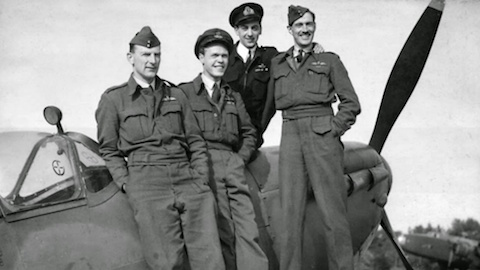
RAE test pilots: From left, Sqd Ldr Anthony “Tony” Martindale, Sqd Ldr James “Jimmy” Nelson, Capt Eric “Winkle” Brown and Sqd Ldr Douglas Weightman. Picture: The Tartanterror blog site.
When flying from Farnborough on that day, according to Surrey Police records, at just after 1pm Sqd Ldr Martindale’s aircraft crashed into a copse somewhere just behind the Jolly Farmer pub on Burdenshott Road.
Transcript from the Surrey Police day book reads:
“13.20/15(Sept), a British Spitfire Mark.IX [actually PR Mk. XI], No PL827 force landed and caught fire and was badly damaged at Whitmoor Common, Worplesdon, MR 427-737. Machine from RAE Farnborough, who were informed by the pilot, Sdn. /Ldr MARTINDALE who was uninjured. Police guard mounted 14.00/15 & relieved at 16.45/15 by RAF guard of 2 men from Farnborough. NFS attended and extinguished the fire. 49 MU not informed as Farnborough will remove machine”.
During this dive, the engine of his aircraft Spitfire PR (Photo Reconnaissance) Mk XI, Serial No.PL827, exploded causing an initial fire, which then went out. However, his windscreen was covered in oil restricting his vision.
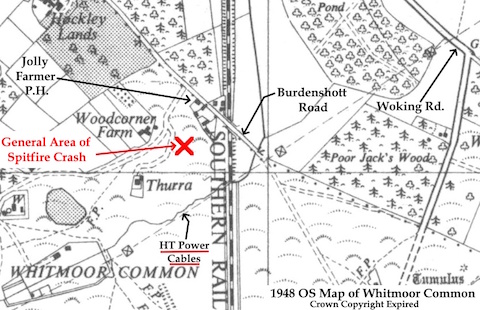
1948 OS map showing part of Whitmoor Common, with added annotation of the general area of the crash site and with the line of high-tension power cables also noted.
Coming in to make a controlled force landing in a field, he did not see some high-tension electricity cables until the last minute. Hitting the cables or in just steering clear of them, he was then unable to avoid the un-powered aircraft crash landing on the common.

The Jolly Farmer pub, Burdenshott Road, today.
Martindale’s Spitfire crash landed in a fairly intact condition before catching fire. Managing to get clear of the aircraft and despite suffering (an undiagnosed at the time) back injury and after removing his parachute, Sqd Ldr Martindale managed to retrieve the important speed recording camera from the aircraft before the fire, due to the crash itself, took hold.

View towards Whitmoor Common from the car park of the Jolly Farmer pub. The aircraft crashed hereabouts.
He also kept onlookers clear before a crew from the National Fire Service arrived and extinguished the fire.
For his heroic actions that day, although initially recommended for the award of the George Medal, Sqd Ldr Martindale was awarded a ‘Bar’ to his Air Force Cross.
In its edition of November 28, 1944, the London Gazette reported the award plus details of the crash and also included that he “kept onlookers clear until the local fire brigade arrived. This officer’s courage in remaining at the controls undoubtedly saved lives and damage to property, whilst his bravery in returning to his aircraft made available the data recorded on this test”.
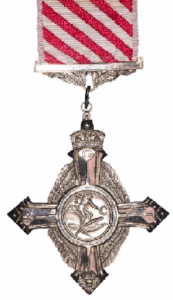
An Air Force Cross medal. Picture: New Zealand Defence Force Personnel and Archive Medals.
Based on the recommendation for his award for the Whitmoor Common incident, a George Medal would seem to have been a more fitting tribute. However, probably due to the secret nature of his work, the ‘Bar’ to the Air Force Cross would have gone better “under the radar” at the time.
On a previous occasion to this incident, on April 27 1944, in another extraordinary display of airmanship, Sqd Ldr Martindale achieved the fastest ever speed attained in a piston-engined fighter in an accurately recorded dive with a speed of Mach 0.91 (620mph at 27,000 feet) in Spitfire PR Mk XI, Serial No. EN409.
During this high-speed dive his Spitfire’s propeller gearing failed, allowing the propeller to overspeed and rip itself off. The loss of the heavy propeller meant that the aircraft’s centre of gravity rapidly changed. With the lightened nose the Spitfire was abruptly snapped into a steep climb with the sudden ‘G’ forces causing the pilot to black out.
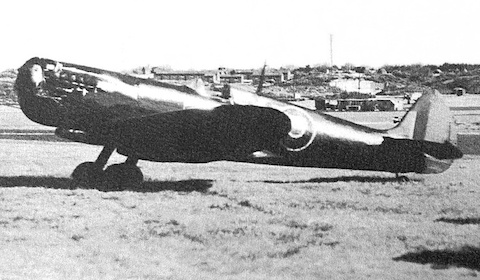
Sqd Ldr Martindale’s Mk XI Spitfire after the April 1944 incident. Picture: Wikimedia Commons.
When he regained consciousness at 40,000 feet, he found that he now had an aircraft with newly slightly swept back (originally straight) wings! He then carefully succeeded in gliding his aircraft 20 miles back to the airfield at Farnborough and landed safely. For his brave airmanship in this situation, he received the Air Force Cross.
Anthony Featherstonehaugh Martindale was born on October 25, 1910. His parents were George and Lillian Martindale from Heswall-cum-Oldfield, Cheshire, (now in Merseyside).
Martindale was admitted to the Institution of Automobile Engineers in 1938. In 1939 he was a pilot in the Royal Air Force Volunteer Reserve at the De Havilland School of Flying.
After the Second World War, Martindale became chief development engineer for the Motor Car Division of Rolls Royce. He died on July 14, 1959.
Responses to Wartime High-speed Test Pilot’s Dramatic Crash Landing on Whitmoor Common, Worplesdon
Leave a Comment Cancel reply
Please see our comments policy. All comments are moderated and may take time to appear. Full names, or at least initial and surname, must be given.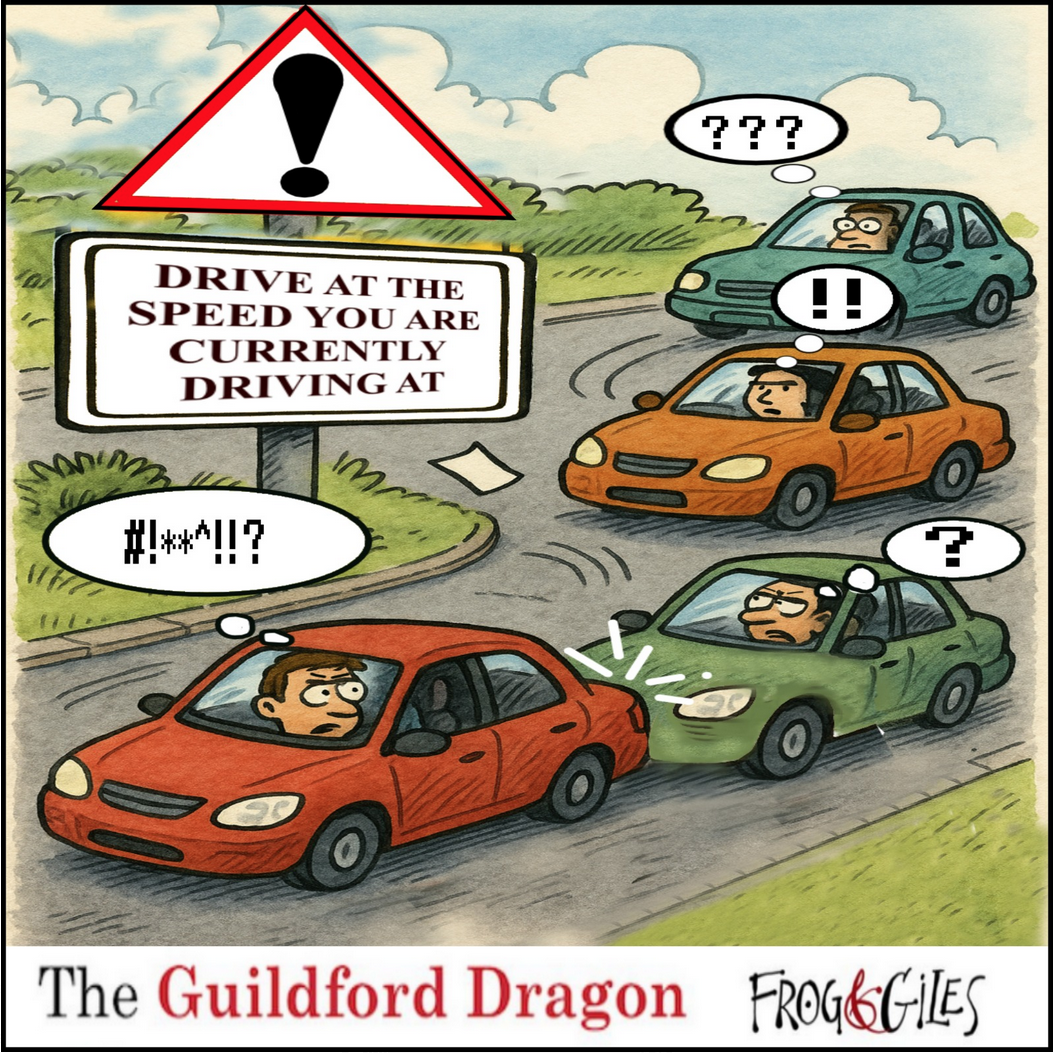
Click on cartoon for Dragon story: Public Asked for Views on SCC’s Proposal for Reduced Speed Limits


Recent Articles
- A281 At Shalford Has Now Reopened Following Repairs To Damaged Roof
- Frimley Park at the Beginning of the Hospital Rebuild Queue
- Letter: Council Has Quietly Relieved Developer of £Million Obligation
- The Royal Surrey Hospital to Open Its Doors to the Public for Community Open Day
- Summary of GBC Planning Decisions – June 18, 2025
- Letter: Reflecting on the Juneja Case Shows the Importance of the Monitoring Officer Role
- New Electric Trains Now Arriving at Guildford – 100 Years After the First One Did
- Woman Pedestrian Dies on A31 After Collision With a Truck
- Road Closed After Lorry Hits Railway Bridge
- The Bishop’s Leap of Faith – From the Top of the Cathedral


Recent Comments
- H Trevor Jones on Residents Urged to Have Their Say on the Changing Shape of Surrey’s Local Government
- Alistair Smith on A281 At Shalford Has Now Reopened Following Repairs To Damaged Roof
- Roland Dunster on GBC’s Plan For a Thriving Guildford ‘Is Our Promise to Residents’ Says Council Leader
- Richard Benson on GBC’s Plan For a Thriving Guildford ‘Is Our Promise to Residents’ Says Council Leader
- Nigel Base on Letter: Recreational Rowing Might Be the Answer
- Anna Windebank on GBC’s Plan For a Thriving Guildford ‘Is Our Promise to Residents’ Says Council Leader
Search in Site
Media Gallery
Dragon Interview: Local Artist Leaves Her Mark At One of England’s Most Historic Buildings
January 21, 2023 / No Comment / Read MoreDragon Interview: Lib Dem Planning Chair: ‘Current Policy Doesn’t Work for Local People’
January 19, 2023 / No Comment / Read MoreA3 Tunnel in Guildford ‘Necessary’ for New Homes, Says Guildford’s MP
January 10, 2023 / No Comment / Read More‘Madness’ for London Road Scheme to Go Ahead Against ‘Huge Opposition’, Says SCC Leader
January 6, 2023 / No Comment / Read MoreCouncillor’s Son Starts Campaign for More Consultation on North Street Plan
December 30, 2022 / No Comment / Read MoreCounty Council Climbs Down Over London Road Works – Further ‘Engagement’ Period Announced
December 14, 2022 / No Comment / Read MoreDragon Interview: GBC Reaction to the Government’s Expected Decision to Relax Housing Targets
December 7, 2022 / No Comment / Read MoreHow Can Our Town Centre Businesses Recover? Watch the Shop Front Debate
May 18, 2020 / No Comment / Read More






Jan Messinger
September 15, 2024 at 8:29 pm
Loving finding out more of the history of Worplesdon . Thank you Frank